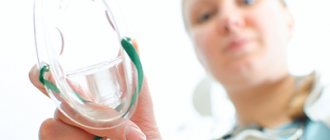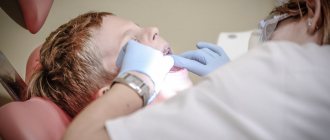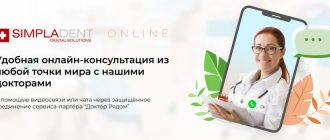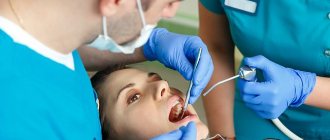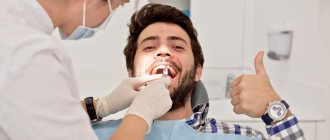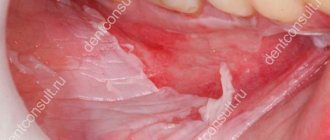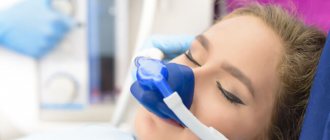Anesthesia is a method of anesthesia in which, after the administration of special drugs, not only the feeling of pain, but also consciousness is turned off.
According to current legislation, in Russia, children under three years of age must undergo dental procedures in the oral cavity under general anesthesia. Sanitation of the oral cavity for children over three years of age is carried out under any anesthesia that ensures painless procedures.
Among parents there is a diametrically opposite attitude towards anesthesia. Some advocate that this method of pain relief be used during even the most harmless procedure, so that the child does not suffer psychological trauma from dental intervention. Others, on the contrary, are distrustful of general anesthesia, regarding it as a health hazard. Let's look at the pros and cons.
Pediatric anesthesia in dentistry
First, let's figure out what anesthesia is. This is a reversible inhibition of the activity of the central nervous system, which we cause artificially.
Narcosis is characterized by:
- falling asleep and decreased reflexes;
- loss of consciousness and muscle relaxation;
- complete absence of painful sensations.
Translated into simple language, this means that during general anesthesia the child falls deeply asleep, lies motionless during the procedure and does not feel anything. And after waking up he doesn’t remember anything.
They are immersed in this state using a combination of several drugs, which ensures safety and comfort for the baby. At the same time, safety comes first. Modern methods of general anesthesia completely eliminate the negative impact on the mental and physical development of a small patient.
Unlike adult dentistry, in pediatric dentistry there is no intermediate option between superficial sedation and anesthesia. This means that for children under 16 years of age there are only two options for “sleep treatment”: superficial sedation, when the child remains awake during treatment, and general anesthesia (endotracheal anesthesia). This is due to the anatomical and physiological characteristics of children. Because of them, deep intravenous sedation is impossible.
Nitrous oxide
Dental treatment with nitrous oxide for children is the simplest and safest method of inhalation sedation, which relieves stress and moderate fear during dental procedures. The history of the use of ZAKS, a mixture of gases N2O and O2, goes back more than 150 years. This type of anesthesia is still used by dentists in Europe, America and Israel.
The child is in a relaxed state and in a good mood, while he is conscious and all his reflexes are preserved: he breathes independently, can move, and answer questions.
The sedative mixture is supplied in the following order:
- during direct communication, the doctor suggests wearing a mask, this may be part of some kind of game;
- first, the child breathes oxygen, then nitrous oxide is added to the mixture until it reaches a concentration of 30%;
- treatment is carried out under the control of devices;
- after the end, oxygen again replaces N2O;
- then the mask is removed.
After just 10 minutes, there are no traces of gas inhalation left in children's lungs.
Advantages of the method:
- complete absence of side effects;
- the action begins after a few breaths;
- the effect of inhaling the substance quickly disappears and the patient returns to his usual state;
- it is a safe alternative to deep anesthesia;
- the degree of sedation is easily controlled using modern electronic-automatic equipment.
- Disadvantages of the method
- These include the inability to use this type of anesthesia at a young age, when the child does not want (or resists breathing independently through a mask throughout the entire treatment) Therefore, the method is indicated for children over 5-6 years of age.
Nitrous oxide can be used in combination with local anesthesia to enable the administration and enhance the effect of painkillers.
Should children undergo dental treatment under anesthesia when they cry?
If your baby cries at the dentist, he may just be very emotional. And then, to calm him down, kind words are enough.
An experienced doctor knows how to find a common language with children, and there are usually no difficulties with treatment. There are many adaptive techniques when the doctor explains to the child in a playful manner that treatment is interesting and not painful at all. In addition, to cope with your baby’s fear, you can use the help of a psychologist.
If these methods do not help, then you can try the procedure under sedation. It muffles fear and temporarily dulls the baby's reactions.
Tears are not a good reason to perform dental treatment under anesthesia in children. It is worth resorting to it only if other methods of “agreeing” have not been successful. Anesthesia in pediatric dentistry is used if there are indications for it.
Treatment of baby teeth under anesthesia is carried out:
- if it is impossible to establish contact with the baby;
- dental treatment for children under 3 years of age;
- allergies to local anesthesia;
- mental illnesses or nervous system disorders: schizophrenia, epilepsy, Parkinson's disease, cerebral palsy, mental retardation;
- insurmountable fear of dental treatment (scientifically called dentophobia);
- strong gag reflex, which interferes with the treatment of distant teeth;
- extensive surgical operations: complex tooth extraction, abscesses, periostitis, lymphadenitis, serious jaw injuries.
When children should not use anesthesia for dental treatment:
✔
during the acute course of the infectious process;
✔
with decompensation of severe chronic diseases.
In general, there are no absolute contraindications to general anesthesia in children. Sometimes you just need to wait for the right moment or choose the most suitable technique. If the baby has an acute situation - pain or injury - there is always the opportunity to safely and comfortably undergo treatment under anesthesia.
Indications and contraindications
There are certain indications for the use of anesthesia. This:
- a large volume of therapeutic and surgical manipulations necessary for complete rehabilitation;
- duration and pain of the planned intervention;
- the presence of purulent processes (abscesses, phlegmon), in which local anesthesia is ineffective;
- the possibility of carrying out a complete rehabilitation in one session;
- mental characteristics of the child;
- neurological diseases;
- allergies to medications used for local anesthesia;
- pronounced gag reflex;
- bronchial asthma;
- Dental phobia - an insurmountable fear of visiting the dentist, based on previous negative experiences;
- the desire of the parents, but there must be no contraindications.
In dental practice, there are also contraindications for general anesthesia, which the doctor must take into account. These include:
- acute respiratory diseases;
- decompensated cardiovascular pathology;
- liver and kidney diseases;
- pathologies of the endocrine system;
- severe form of rickets;
- recent vaccination;
- recent food intake;
- body temperature is higher than normal.
How to prepare a child for dental treatment under anesthesia
- Before treatment, you should consult with an anesthesiologist. This can usually be done over the phone, but in some cases a face-to-face appointment is required.
To correctly administer general anesthesia, the anesthesiologist will need the following information:
- child development history;
- allergic reactions;
- past acute and chronic diseases;
- previous medical interventions and hospitalizations;
- anthropometric data (age, height, weight).
To clarify the child’s health status, you will need to undergo a series of tests. The anesthesiologist determines the full scope of the required examination based on the characteristics of the small patient and the type of upcoming treatment.
- Before anesthesia, diet is very important. The safety of anesthesia depends on its compliance.
The child who will best tolerate anesthesia is the one who:
- did not eat “heavy food” during the 6 hours preceding treatment;
- 4 hours before the procedure I had a snack;
- I drank water 2 hours before.
Dietary recommendations may vary, so the final meal plan will be discussed in consultation with the anesthesiologist.
- To help parents not be nervous, I also recommend asking the anesthesiologist what his qualifications are and what equipment he will use during the procedure. You definitely shouldn’t be embarrassed about such questions. Doctors with experience in pediatric anesthesiology should work with children, since the structure of the child’s body and its functioning have their own characteristics.
Developmental features or concomitant diagnoses of the patient
Sleep treatment under anesthesia is suitable for children with autism, cerebral palsy, Down syndrome, and epilepsy.
Whims, tears and reluctance to be treated are corrected by adaptation. Aza&Buka doctors have extensive experience in communicating with different patients and find an approach to everyone. Treating teeth today is not painful, fun, interesting. And if a doctor recommends treatment in a dream, then there really are indications for this.
How is dental treatment performed for children under anesthesia?
During treatment under general anesthesia, the child does not feel anything. And he doesn’t remember anything after waking up. This is achieved by a combination of drugs. The main one among them is Sevoran.
The combination of drugs and their doses are calculated individually for each child. In this case, the doctor takes into account the age, weight and characteristics of the small patient. The use of combinations of anesthetics makes it possible to minimize their doses and carry out a high-quality and safe procedure.
The child falls asleep after a few breaths through the mask of the anesthesia machine. This happens in the arms of the mother. We perform induction of anesthesia as comfortably as possible for the baby. If a child comes with his favorite toy, we show her by example: inhalation from a mask is not scary.
In cases where parents warn the anesthesiologist that even a mask causes negative emotions in the child, premedication can be used. Then we administer a mild sleeping pill to the baby in the form of nasal drops, after which the child plays or watches cartoons for 30-40 minutes and gradually falls asleep in his mother’s arms. And then we begin induction of anesthesia.
An anesthesiologist and a nurse anesthetist are responsible for administering general anesthesia. Their interaction ensures the safety of the child. The baby is under constant control, precisely calculated doses of drugs are administered at the appropriate time. It takes approximately 30 minutes in addition to the treatment time for the anesthesiologist to induce anesthesia and wake up.
Why choose Aza&Buka: the best pediatric dentist with anesthesia
In Moscow, many clinics provide dental treatment for children under general anesthesia and at different prices, but patients choose Aza&Buka. Reasons for visiting a pediatric dental clinic:
- Our own team of anesthesiologists - a doctor and assistants. The anesthesiologist consults the patient's parents before treatment begins and stays with the child while he sleeps. And be sure to wait until the baby fully recovers from anesthesia.
- Modern equipment, tools, drugs. The best sleep monitoring equipment allows you to monitor the depth and quality of anesthesia and the patient’s condition. The software calculation of the dose of the anesthesia drug is carried out according to the individual parameters of the child.
- Experienced specialists of any profile. At the Aza&Buka children's clinic, under anesthesia, a child is offered not only the treatment of caries, but also the elimination of pulpitis, removal of baby teeth, and prosthetic crowns when indicated.
What is rehabilitation like after treatment under anesthesia?
After waking up from anesthesia, in the vast majority of cases, children feel well. Most often, the only thing that bothers them is numbness in the areas where the local anesthetic was injected.
As for behavioral changes, there are three types:
- excitement - the baby may be capricious and cry. This is accompanied by increased activity. But it quickly gives way to fatigue;
- fatigue - the child wants to sleep, refuses to eat, sits in the arms of the parents;
- no behavioral changes after waking up.
The first two scenarios are typical for children under the age of 7-10 years, the third - for adolescents and adults.
Hyperactivity and agitation upon awakening are unpleasant for both the child and those around him. To avoid it, we try to implement the second scenario; to do this, we put the baby to sleep and wake him up gently.
The child can eat immediately after waking up, unless the anesthesiologist gives other recommendations.
Very rarely, recovery from anesthesia is accompanied by nausea or a feeling of motion sickness. This lasts no longer than 2-3 hours. This reaction is typical for children who get motion sickness in transport. In this case, you will be able to eat and drink within an hour or after the nausea has passed.
There is no need to worry about the postoperative period - the anesthesiologist will always be in touch.
Reviews from parents and impressions of children
Irina
Dental treatment for a child under anesthesia is very exciting for parents. My daughter is only 4.5 years old, so I was looking for the best specialists. And I found it. Many thanks to the anesthesiologist at the Azabuka clinic, dentists and all the staff. Everything went just fine and with minimal stress for the parents. Thank you for helping!
I put Aza&Buka:
5
Anna
Angela
I liked the integrated approach in Azabuka. My daughter was first given an x-ray, then taken to the office and offered to try on breathtakingly fashionable glasses for safe treatment. The dentist has a fun anesthesia for children - nitrous oxide. It is responsible for relaxation and comfort and my daughter really liked it. The teeth were healed quickly and very well. The fillings are invisible. But the main thing is the wonderful mood from the clinic’s doctors. Thank you!
I put Aza&Buka:
5
Irina
Dmitriy
My son’s serious diagnoses do not allow us to fully care for his teeth, so every few years we treat the child’s teeth under general anesthesia. The Azabuka clinic pleasantly pleased with its approach. Full examination, separate anesthesiologist, modern equipment, excellent dentists. Everything is fast, neat and very kind to the patient. Doctors make you feel good and children are drawn to them. And parents are pleased with such high professionalism and sincere care. Thank you very much!
I put Aza&Buka:
5
Ilya
Alexandra and Evgeniy
We often visit Aza&Buka dentistry - we regularly bring our children for preventive appointments and dental examinations. I like the warm, even bright atmosphere in the offices and corridors, and especially the doctor. The clinic’s doctors are excellent specialists and even better psychologists. They easily negotiate with children, they immediately became friends. We recommend!
I put Aza&Buka:
5
Zhenya
Irina
The first appointment was planned in detail: we talked with our daughter, watched the video website. Lisa really liked the funny characters Aza and Buk, and at the appointment she only talked about them with the doctor. I decided that I would take care of my teeth like Aza and sat calmly in the chair throughout the entire appointment. Great idea, great execution. And the doctors are just great.
I put Aza&Buka:
5
Dasha
Svetlana
We were looking for a sincere and good doctor for our Vasya. The diagnosis of cerebral palsy often became a reason for refusal. The child is complex, the doctors could not find an approach. We have already started thinking about treatment under anesthesia. Aza&Buka dentists offered sedation, treatment while half asleep - they kindly and calmly agreed with the child. The teeth were cured quickly - without whims or fear. Thank you!
I put Aza&Buka:
5
Vasya
Stages of treatment
The course of treatment with Propofol includes several stages:
- Introduction to sleep. A child with his parents enters the dentist’s office, sits in a chair, is given a light anesthesia through a mask, and then Propofol is injected. The little patient falls asleep almost instantly.
- The necessary dental procedures are carried out - the dentist removes teeth, treats caries or pulpitis and performs other necessary manipulations. All the time, the anesthesiologist monitors the depth of sleep and the dosage of the drug administered using BIS monitoring, monitors the child’s condition, blood counts, incl. pressure, oxygen saturation, heart rate - using the most modern equipment.
- Awakening. The supply of the drug stops and most often the child wakes up after 10-15 minutes, but sometimes this takes a little longer - up to 30-40 minutes. The baby can safely get as much sleep as he needs in a separate room. After the final awakening and follow-up examination, the healthy child goes home with his parents.
In very rare cases, the patient experiences nausea and dizziness upon awakening, but such effects occur infrequently and pass very quickly. In addition, a long-term consequence of sedation in some patients may be a calmer (than normal) state for several hours after anesthesia.
Types of anesthesia
If you need to remove a baby tooth that is already loose, this can often be done without anesthesia. In other cases, pain relief is required. Modern anesthesia drugs do not have a negative effect on the child’s body; their use is recommended by the Ministry of Health and STAR (Russian Dental Association).
In dentistry, several methods of pain relief are most often used:
- local anesthesia;
- general anesthesia (anesthesia);
- sedation
Local anesthesia
Methods of local anesthesia used in dentistry to treat children:
- application - the drug is applied to the surface of the tissue, it anesthetizes the mucous membrane for a short time, is used for anesthesia before an injection or before extracting a loose tooth;
- infiltration – the medicine is administered by injection into the mucous membrane of the gums to anesthetize the tissues surrounding the tooth;
- conductive – allows you to anesthetize and block the trunk of the nerve innervating the neurovascular bundle of a given tooth.;
- intraligamentary - a method of anesthesia in which the medicine is injected into the tissue between the root cement and the socket.
When teeth are removed, children often use two-stage local anesthesia: first, the gums are numbed with “tasty” gels or solutions, and then the medicine is administered by injection. For injections, toy attachments are used so that the child is not afraid of the syringe.
General anesthesia
Immersion in a state of anesthesia occurs through intravenous administration of drugs or through a mask. In this state, the child does not feel pain, his muscular system is completely relaxed. Indications for the use of general anesthesia are:
- the need for dental intervention in a child under 2 years of age;
- difficult removal;
- severe fear in the child;
- removal of several teeth;
- allergies to painkillers;
- large volume of treatment
- neurological diseases.
The decision to use anesthesia is made taking into account all the characteristics of the child’s body.
Sedation
The oxygen-nitrogen sedation technique allows the child to remain conscious and respond to the doctor’s questions. Through a special mask, the child inhales gas (nitrous oxide), with the help of which he relaxes and calms down.
Inhalation sedation does not require preliminary preparation (except for eliminating food 4 hours before).
For tooth extraction, sedation is used in combination with local anesthesia: gas inhaled through a mask calms the patient, and the anesthetic numbs the desired area. The effect occurs within a few minutes and ends when the gas supply is stopped.
Oxygen-nitrogen sedation in pediatric dentistry is a safe sedative. Nitrous oxide does not cause addiction or allergies, does not bind to blood proteins and is completely eliminated from the body through the lungs within a few minutes. Oxygen-nitrogen sedation has been used in world dentistry for more than fifty years.
Indications for removal of baby teeth
In children aged 6-7 years, the process of natural tooth replacement begins, the roots of baby teeth gradually dissolve, the crowns become loose and fall out on their own.
In some cases, the help of a dentist is still required:
- caries in an advanced stage, when tooth restoration is not possible;
- tooth decay caused by trauma;
- the crown of the tooth is already loosened, but does not fall out, causing discomfort to the child and injuring the gums;
- The permanent tooth has already begun to emerge, but the milk tooth is still firmly seated and does not make room;
- orthodontist recommendations for the formation of a correct bite;
- fistula, periodontitis, cyst.
Removal of incisors is most often associated with fractures and chips caused by trauma.
Permissible dosage of propofol for children
When administering Propofol to children, the dose is calculated by the anesthesiologist depending on the individual characteristics of the particular patient. But in general, the recommended dosage for children over 8 years of age is 2.5 mg/kg of body weight - for introducing medicated sleep. For children under 8 years of age, the dosage may be higher. The maintenance dosage of Propofol for children with deep sedation in dentistry averages 9-15 mg/kg per hour.
For children with severe illnesses, the dosage should be lower. The exact dosage in each specific case is determined and controlled by the anesthesiologist, taking into account the condition and susceptibility of the patient.
Alternatives to anesthesia
If the main reason for considering the possibility of using anesthesia during tooth extraction is the child’s fear, then as an alternative, a simpler way to solve the problem can be offered. We are talking about the use of a method such as oxygen-nitrogen sedation, which has nothing to do with anesthesia. The child simply inhales a mixture of sedative gases through a mask and psychologically relaxes. Thus, after the teeth are removed, he is left with only positive emotions. At the same time, during sedation, the baby does not sleep, is conscious, breathes and speaks independently. In parallel with sedation, local anesthesia is used to eliminate pain. However, it is not recommended to use this method if the child does not have nasal breathing or during periods of exacerbation of chronic diseases.
